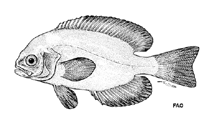http://www.fishbase.org/Summary/speciesSummary.php?genusname=Schedophilus&speciesname=pemarco ---> http://192.134.151.83/Summary/speciesSummary.php?genusname=Schedophilus&speciesname=pemarco
http://192.134.151.83/Summary/speciesSummary.php?genusname=Schedophilus&speciesname=pemarco ---> https://fishbase.mnhn.fr/Summary/speciesSummary.php?genusname=Schedophilus&speciesname=pemarco
https://fishbase.mnhn.fr/Summary/speciesSummary.php?genusname=Schedophilus&speciesname=pemarco ---> https://fishbase.mnhn.fr/summary/Schedophilus-pemarco.html
Schedophilus pemarco, Pemarco blackfish : fisheries

You can
sponsor
this page
Common name (e.g. trout)
Genus + Species (e.g. Gadus morhua)
-

-
About this page
-
Languages
-
User feedbacks
-
Citation
-
Uploads
-
Related species
-


 Pemarco blackfish
Add your observation in
Fish Watcher
Upload your
photos
and
videos
Pemarco blackfish
Add your observation in
Fish Watcher
Upload your
photos
and
videos
Pictures
|
Google image
 Schedophilus pemarco
Schedophilus pemarco
Picture by
FAO
Teleostei (teleosts) >
Scombriformes
(Mackerels) >
Centrolophidae
(Medusafishes)
Etymology:
Schedophilus:
Name from Greek words 'phylos' (Φίλος), t) meaning 'one who likes' and "s 'shedia' (Σχεδία) which means raft; literally means 'the one who likes rafts'. This probably refers to the lifestyle ot the juveniles of this genus (Michail Ragousis, mar10091@marine.aegean.gr, pers. Comm. 01/16) which are epipelagic and associate with floating jellyfish.
.
More on author:
Poll
.
Environment: milieu / climate zone / depth range / distribution range
Ecology
Marine; benthopelagic; depth range 50 - 500 m (Ref.
2683
), usually 100 - 500 m (Ref.
26999
). Deep-water; 21°N - 29°S, 71°W - 16°E
Eastern Atlantic: Cape Blanc, Mauritania to the Kunene River, Angola. Reported from Namibia (Ref.
27121
). Western Atlantic: occurrence in Venezuela is based on 4 samples taken from the coast, of which only one is larger than 20 cm TL (Ref.
13628
).
Size / Weight / Age
Maturity: L
m
?
range ? - ? cm
Max length : 50.0 cm TL male/unsexed; (Ref.
2683
); common length : 30.0 cm TL male/unsexed; (Ref.
2683
)
Dorsal
spines
(total): 5 - 7;
Dorsal
soft rays
(total): 23-26;
Anal
spines
: 3;
Anal
soft rays
: 16 - 18. Dark grey-blue to brownish in color; juveniles with irregular horizontal stripes on flanks; fins darker than body; pelvic fins black; eye bluish (Ref.
4410
).
Inhabits shelf and slope waters (Ref.
2683
).
Life cycle and mating behavior
Maturity
|
Reproduction
|
Spawning
|
Eggs
|
Fecundity
|
Larvae
Haedrich, R.L.
, 1990. Centrolophidae. p. 1011-1013. In J.C. Quero, J.C. Hureau, C. Karrer, A. Post and L. Saldanha (eds.) Check-list of the fishes of the eastern tropical Atlantic (CLOFETA). JNICT, Lisbon; SEI, Paris; and UNESCO, Paris. Vol. 2. (Ref.
6942
)
IUCN Red List Status (Ref.
130435
)
Least Concern (LC)
; Date assessed:
04 February 2009
CITES
Not Evaluated
Not Evaluated
Threat to humans
Harmless
Human uses
Fisheries: commercial
FAO - Fisheries:
landings
; Publication:
search
|
FishSource
|
Sea Around Us
More information
Countries
FAO areas
Ecosystems
Occurrences
Introductions
Stocks
Ecology
Diet
Food items
Food consumption
Ration
Common names
Synonyms
Metabolism
Predators
Ecotoxicology
Reproduction
Maturity
Spawning
Spawning aggregation
Fecundity
Eggs
Egg development
Age/Size
Growth
Length-weight
Length-length
Length-frequencies
Morphometrics
Morphology
Larvae
Larval dynamics
Recruitment
Abundance
BRUVS
References
Aquaculture
Aquaculture profile
Strains
Genetics
Electrophoreses
Heritability
Diseases
Processing
Nutrients
Mass conversion
Collaborators
Pictures
Stamps, Coins Misc.
Sounds
Ciguatera
Speed
Swim. type
Gill area
Otoliths
Brains
Vision
Tools
E-book
|
Field guide
|
Identification keys
|
Length-frequency wizard
|
Life-history tool
|
Point map
|
Classification Tree
|
Catch-MSY
|
Special reports
Check for Aquarium maintenance
|
Check for Species Fact Sheets
|
Check for Aquaculture Fact Sheets
Download XML
Summary page
|
Point data
|
Common names
|
Photos
Internet sources
AFORO (otoliths) |
Aquatic Commons
|
BHL
|
Cloffa
|
BOLDSystems
|
Websites from users
|
Check FishWatcher
|
CISTI
|
Catalog of Fishes
:
genus
,
species
|
DiscoverLife
|
ECOTOX
| FAO - Fisheries:
landings
; Publication:
search
|
Faunafri
| Fishipedia |
Fishtrace
| GenBank:
genome
,
nucleotide
|
GloBI
|
Google Books
|
Google Scholar
|
Google
| IGFA World Record |
MitoFish
|
Otolith Atlas of Taiwan Fishes
|
PubMed
| Reef Life Survey | Socotra Atlas |
Tree of Life
| Wikipedia:
Go
,
Search
| World Records Freshwater Fishing |
Zoological Record
Estimates based on models
Preferred temperature (Ref.
123201
): 7.3 - 16.9, mean 13.3 °C (based on 71 cells).
Phylogenetic diversity index (Ref.
82804
): PD
50
= 0.5039 [Uniqueness, from 0.5 = low to 2.0 = high].
Bayesian length-weight: a=0.01380 (0.00555 - 0.03435), b=3.06 (2.85 - 3.27), in cm total length, based on LWR estimates for this (Sub)family-body shape (Ref.
93245
).
Trophic level (Ref.
69278
): 4.0 ±0.28 se; based on food items.
Resilience (Ref.
120179
): Medium, minimum population doubling time 1.4 - 4.4 years (Preliminary K or Fecundity.).
Fishing Vulnerability (Ref.
59153
): Moderate vulnerability (40 of 100).
Climate Vulnerability (Ref.
125649
): Moderate to high vulnerability (47 of 100).
Price category (Ref.
80766
):
Very high
.
Nutrients (Ref.
124155
): Calcium = 17.8 [9.5, 36.4] mg/100g; Iron = 0.367 [0.121, 0.735] mg/100g; Protein = 17 [15, 19] %; Omega3 = 0.296 [0.144, 0.609] g/100g; Selenium = 18.7 [7.5, 42.9] μg/100g; VitaminA = 15.7 [2.9, 84.0] μg/100g; Zinc = 0.319 [0.204, 0.493] mg/100g (wet weight);
Back to Search
Random Species
Back to Top
Accessed through:
Not available
FishBase mirror site :
localhost
Page last modified by :
mrius-barile
- 20 July 2016
Fatal error
: Uncaught ArgumentCountError: Too few arguments to function checkEcotox(), 1 passed in /var/www/html/summary/speciessummary.php on line 2304 and exactly 3 expected in /var/www/html/includes/speciessummary.lib.php:2579 Stack trace: #0 /var/www/html/summary/speciessummary.php(2304): checkEcotox() #1 {main} thrown in
/var/www/html/includes/speciessummary.lib.php
on line
2579
|